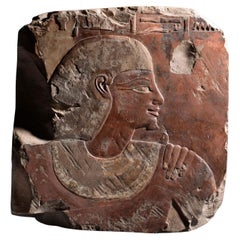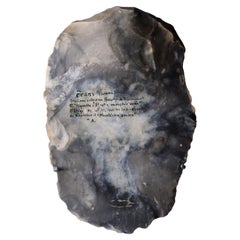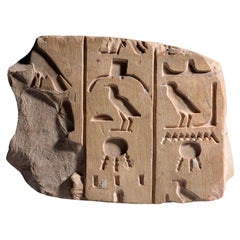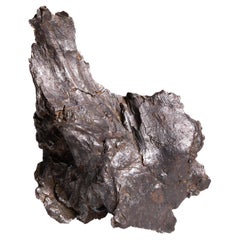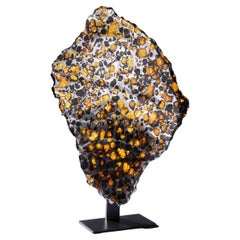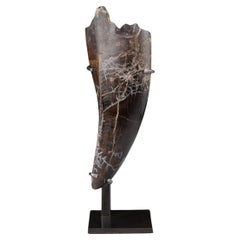ArtAncient
to
1
42
42
Ancient Egyptian Painted Relief Carving of a Man and his Wife
Located in London, GB
A superb raised relief, carved in fine native limestone during a golden era of cultural and artistic flourishing in ancient Egypt. The scene portrays a high-ranking official, elegant...
Category
Antique 15th Century and Earlier Mounted Objects
Materials
Limestone
Neanderthal Flint Core from Prehistoric Northern France
Located in London, GB
A Levallois Flint Core, from Fransu, Somme, Northern France
Middle Palaeolithic, Mousterian, circa 100,000–40,000 years ago
A wonderfully tactile artefact, offering a glimpse into t...
Category
Antique 15th Century and Earlier French Abstract Sculptures
Materials
Stone
Ancient Egyptian Limestone Relief with Hieroglyphs
Located in London, GB
Egyptian New Kingdom Relief Fragment
Carved limestone
New Kingdom, circa 1550-1069 BC
12 x 16.5 cm
This beautiful fragment preserves three columns of neat hieroglyphs deeply carved ...
Category
Antique 15th Century and Earlier Egyptian Mounted Objects
Materials
Limestone
Meteorite Sculpture Formed by Atmospheric Explosion
Located in London, GB
On the morning of 12 February 1947, an enormous iron meteor passed through the Earth’s atmosphere. Exploding over the Sikhote-Alin mountains in South-eastern Russia, it created a fir...
Category
Antique 15th Century and Earlier Natural Specimens
Materials
Iron
Meteorite Fragment with Peridot Crystals in Iron Matrix
Located in London, GB
A complete cross section of one of the most beautiful meteorites known, displaying shimmering, translucent olivine and peridot gems, embedded in an iron-nickel metallic matrix.
The ...
Category
Antique 15th Century and Earlier Chilean Natural Specimens
Materials
Iron
Tyrannosaurus Rex Tooth Fossil
Located in London, GB
FOSSILISED TYRANNOSAURUS REX TOOTH
Circa 67 million years ago
H. 12.5 cm x W. 4.2 cm
PROVENANCE
Found in Butte County, South Dakota, USA, Summ...
Category
Antique 15th Century and Earlier American Natural Specimens
Materials
Other
$133,197
Extraterrestrial Iron Sphere from the Aletai Meteorite
Located in London, GB
A magnificent meteorite sphere, cut from the famous Aletai meteorite and polished to reveal the shimmering iron-nickel matrix and the beautiful crystalline Widmanstätten pattern — a ...
Category
Antique 15th Century and Earlier Natural Specimens
Materials
Iron
Large Sculptural Iron Meteorite
Located in London, GB
Stony-iron, pallasite - PMG
Circa 4.5 Billion y/o
Weight: 34.68 kg
Height (including base): 53 cm
Width: 29 cm
A magnificent and extremely sculptural specimen of the Seymchan meteor...
Category
Antique 15th Century and Earlier Natural Specimens
Materials
Iron
$217,322
Lunar Meteorite - A Piece of the Moon
Located in London, GB
A beautiful section of the lunar meteorite Gadamis 003, discovered in the oasis Berber town of Ghadames, Libya, and revealing a magnificent greyish-white spotted interior, evoking th...
Category
Antique 15th Century and Earlier Natural Specimens
Materials
Stone
Erotic Ancient Greek Wine Cup with Painted Eyes
Located in London, GB
A rare, erotic cup exemplifying the revelry and humour of ancient Greek culture, particularly within the context of symposia - the social drinking parties of the elite. This wine cup...
Category
Antique 15th Century and Earlier European Classical Greek Vases
Materials
Pottery
Ancient Gallo Roman Millstone
Located in London, GB
Gallo-Roman Quernstone
Fécamp, Seine-Maritime, France
Circa 2nd century BC - mid-4th century AD
Carved puddingstone
Diameter: 43 cm
The lower grinding stone from a late Iron Age, ea...
Category
Antique 15th Century and Earlier French Mounted Objects
Materials
Stone
Roman Marble Head of a Satyr
Located in London, GB
Head of a Satyr
Roman, circa 2nd - 3rd century AD
Carved and highly polished marble
An extremely fine marble head of a satyr, depicted with ivy wreath, curly hair and pointed goat’s ear, the full lips slightly parted to reveal the creature’s clenched teeth.
The head was once part of a relief with visible fragmentation on the left side. Almost completely worked in the round and carefully polished, the skill of the sculptor is particularly remarkable given the confined working space available for a relief carving, such as this.
The Roman Imperial Period marked the expansion of the political and cultural influence of the Roman Empire. The period began with the reign of Augustus in 27 BC, immediately following Caesar’s assassination which ultimately ended Rome’s time as a republic. Soon after, Augustus’ defeat of Anthony and...
Category
Antique 15th Century and Earlier Busts
Materials
Marble
$59,000
Ancient Egyptian Monumental Temple Sphinxes
Located in London, GB
A pair of monumental limestone sphinxes of Pharaoh Nectanebo I, from the processional avenue of the Serapeum of Memphis, 30th Dynasty, circa 379 - 360 BC.
The sphinxes of the Serapeum have captivated travellers since Roman times. However, despite their significance, they are conspicuously absent from the collections of most major museums. Indeed, their existence in private hands is so improbable, and their imitations so numerous, that the present sphinxes were assumed to be modern copies throughout their recent ownership history. Finally recognised and conserved after an extraordinary chance discovery at a garden furniture sale...
Category
Antique 15th Century and Earlier Egyptian Egyptian Figurative Sculptures
Materials
Limestone
Fossilized Wood Cross-Section
Located in London, GB
Fossilised wood fragment displaying vibrant streaks of browns, reds, blues and yellows. This is a magnificent example of the results of a fossilisation process known as permineralization.
In the right environment over great lengths of time, buried wood tissue permeated by minerals transported in water can transform into fossils.
This particular example has fossilised over a copper deposit, resulting in bright inclusions of copper minerals that manifest as impressive streaks of blue, yellow, green and red. This distinctive coloration is unique to Colla wood...
Category
Antique 15th Century and Earlier Natural Specimens
Materials
Other
Tyrannosaurus Rex Tooth in Fossil Matrix
Located in London, GB
Tyrannosaurus Rex Tooth in Fossil Matrix.
Late Cretaceous, circa 65 Million years before present.
Lance Formation, Marchant Ranch Quarry, Niobrara County, Wy...
Category
Antique 15th Century and Earlier Natural Specimens
Materials
Other
Bronze Age Cypriot Plank Idol
Located in London, GB
Cypriot Plank Idol
Early Bronze Age III - Middle Bronze Age I, c. 2100 - 1850 BC.
Low fired burnished earthenware pottery with lime-filled incisions
A Cypriot plank idol, an iconic form of human representation from Bronze Age Cyprus...
Category
Antique 15th Century and Earlier Cypriot Abstract Sculptures
Materials
Terracotta
$150,000
Late Bronze Age Sword
Located in London, GB
Saint Nazaire Sword, Late Bronze Age, circa 800-900 B.C.
An exceptionally well preserved Bronze Age sword, with elegant, finely incised decorations,...
Category
Antique 15th Century and Earlier French Abstract Sculptures
Materials
Bronze
$75,000
Sculptural Oriented Meteorite
Located in London, GB
Oriented Chondrite Meteorite Circa 4.56 Billion y/o
Chondrite
24 x 20 cm, 28 cm tall on base
7.1 kg
A sculptural and beautifully weathered chondrite meteorite; upon entering the atmosphere, this extraterrestrial stone would have heated the surrounding air to a temperature of over 1700 C, higher than that of the hottest lava on the planet, and enough to melt away its outer layers, leaving its surface rippled with regmaglypts, thumb-shaped impressions formed as superheated rock streaked off of the main body as it careened toward the earth. The last layer of the rock to melt would have re-solidified as the meteorite made impact, forming a charcoal coloured fusion crust, which has taken on a deep ochre-tinted patina.
Chondrite meteorites such as this example were formed at the very beginning of our solar system, by the accretion of various types of dust and small grains, adrift in the vacuum of space and, as such, provide important clues about the birth of our own planet. This piece is an especially rare specimen, known as an oriented meteorite...
Category
Antique 15th Century and Earlier Natural Specimens
Materials
Stone
Ancient South Arabian Alabaster Statue
Located in London, GB
South Arabian Calcite female figure
3rd Century BC to 1st century A.D.
Calcite Alabaster
height: 30.5 cm
A magnificent alabaster female figure, a f...
Category
Antique 15th Century and Earlier Yemeni Figurative Sculptures
Materials
Alabaster
Natural Gogotte Formation
Located in London, GB
A magnificent example of a gogotte formation composed of thick swirls and folds of sparkling sandstone. Discovered in the Oligocene sand dunes of Fontainebleau, France, formed circa 30 million years before present or later.
The incredible, almost otherworldly appearance of gogottes may easily be mistaken for the work of a most talented artist. In fact, these sandstone sculptures are entirely natural in origin. They have been found in multiple locations but those from Fontainebleau, such as the present example, are the most remarkable. Thirty-five million years ago, a sea covered what is now the forest of Fontainebleau, and dunes of exceptionally fine and homogenous sand formed. As silica-rich water filtered through this sand, it turned into stone. The flow of water finely modelled the sandstone into the aesthetic concretions we now know as gogottes. These are rare and are only found sporadically several metres deep into the ground. They owe their sparkling white appearance to the extreme and unmatched purity of the Fontainebleau sand, sometimes reaching a composition of 99.9% silica. Each of them is unique – a masterpiece slowly fashioned by the hands of Nature.
The intriguing name of “gogotte” was coined by French geologist Claude Guillemin (1923- 1994), who was inspired by the children’s book series Babar the Elephant. In one of the books, a group of monsters called Gogottes are shown hiding behind rocks. These rocks reminded Guillemin of the sandstone concretions...
Category
Antique 15th Century and Earlier Natural Specimens
Materials
Other
$55,000
Ancient Greek Perfume Bottle
Located in London, GB
Athenian Black-glaze perfume pot with inscription
Athens, c. 425-400 B.C.
Terracotta
Measures: Height: 9cm; diameter across lip: 7.5cm; width including handle: 9cm
This 5th Cen...
Category
Antique 15th Century and Earlier Italian Classical Greek Bottles
Materials
Pottery
Gogotte Formation
Located in London, GB
Gogotte formation
circa 30 Million y/o
Measures : 42 x 21 x 63 cm.
A magnificent example of a gogotte formation, composed of thick swirls and fo...
Category
Antique 15th Century and Earlier French Natural Specimens
Materials
Sandstone
$65,000
Oriented Stone Meteorite
Located in London, GB
Oriented Stone Meteorite
Chondrite
5.00 kg
Detached from its parent body by a mighty impact, this large, oriented Meteorite travelled over a hu...
Category
Antique 15th Century and Earlier North African Natural Specimens
Materials
Stone
$46,500
Ancient Roman Turquoise Glass Cup
Located in London, GB
Turquoise glass cup
Roman Empire, circa 3rd-4th century A.D.
With old label reading ‘’965’’.
“Pliny relates that the art of glass-making [.] was actua...
Category
Antique 15th Century and Earlier Italian Classical Roman Glass
Materials
Glass
Ancient Greek Black Glaze Ribbed Mug
Located in London, GB
Greek black-glaze ribbed mug
Athens, circa 475-425 B.C.
terracotta.
The mug is of a straight-sided, cylindrical form with seven horizontal ribs and an applied ring handle just below the lip. The base is flat with a slightly raised foot running around the circumference. The very centre of the underside is reserved and with traces of ochre pigment. Intact, some slight chipping to the glaze touched in, areas of incrustation to the base and interior.
This strikingly modern piece is a fine example of Attic black...
Category
Antique 15th Century and Earlier Greek Classical Greek Ceramics
Materials
Terracotta
Lunar Meteorite - A piece of the Moon
Located in London, GB
A beautiful fragment from a lunar meteorite, among the rarest of all geological finds. This specimen belongs to NWA 11303, a feldspathic regolith breccia which formed when the shock ...
Category
Antique 15th Century and Earlier Algerian Natural Specimens
Materials
Stone
$4,900 Sale Price
65% Off
Roman Marble Statuette of Jupiter
Located in London, GB
Roman Marble Fragment of jupiter
Circa 2nd-3rd Century A.D.
Measure: Height: 19.7 cm
This beautiful Roman fragmentary statuette depicts Jupiter, the king of the gods, here recognisable from his two chief attributes, the eagle with outstretched wings - according the Pseudo-Hyginus, singled out by Jupiter because ''it alone, men say, strives to fly straight into the rays of the rising sun'' - and the base of the scepter, which remains at the side of the left foot, an aspect likely borrowed from the statue of Zeus at Olympia, once one of the Seven Wonders of the World. Though much of the original piece has been lost, the subtle anatomical detail in the feet mark this out as a piece of exceptional quality, and the work of an artist of particular talent and patience - as Johann Winckelmann once said of the famous Belvedere Torso, ''if you contemplate this with a quiet eye [...] the god will at once become visible in this stone.''
This fragment once caught the eye of Henry Howard, 4th Earl of Carlisle (1694-1758), a Knight of the Garter and among the most prolific collectors of his day. The piece, acquired during his travels to Rome, was proudly displayed on an alcove of the Western Staircase of Castle Howard...
Category
Antique 15th Century and Earlier Italian Classical Roman Figurative Scul...
Materials
Marble
Roman Marble Foot
Located in London, GB
Roman marble Fragment of a Right Foot with Sandal
Circa 1st - 2nd Century A.D.
An evocative Roman marble fragment, preserving the front portion of an over-lifesized sandalled foot. The toes, nails, and bridge of the foot have been sensitively carved. The outer sole of the sandal remains, with delicate, pointed straps joining between the first two toes in a diamond shape.
This fragment once belonged to Danish sculptor Jens Adolf Jerichau...
Category
Antique 15th Century and Earlier Italian Classical Roman Figurative Scul...
Materials
Marble
$22,000
Roman Marble Head of Sophocles
Located in London, GB
Roman Marble Head of Sophocles
Circa 1st-2nd Century
Marble
This fine Roman marble head preserves the proper left side of the face of a middle-aged man, with broad nose, soft lips, and bearded chin. The short beard and sideburns have been finely carved with a flat chisel, to render the soft, wavy strands of hair. The cheekbone, undereye, and nasolabial folds have been delicately modelled in the marble by a skilled hand. In a letter from 1975, the former director of Ny Carlsberg Glyptotek, Copenhagen, suggested that the head could depict the Ancient Greek tragedian Sophocles.
Few figures in the Classical world stand aside Sophocles (c. 496-406 BC), inarguably the best known of the Athenian tragedians, in terms of the impact his works have had on the history of art and literature. The psychological depth he achieves in the seven of the 123 of his plays that have survived to the present day - most notably the three Theban plays: Antigone, Oedipus the King, and Oedipus at Colonus - not only inspired the Athenians, among whom Sophocles was honoured as a hero long after his death, but in our own time, have provoked landmark works on phychoanalysis and literary criticism, by thinkers like René Girard and, most famously, Sigmund Freud. In its masterful treatment of the marble this fragment sensitively captures the features of one of the most important playwrights of all time.
Height on stand: 7.9 inches (20 cm).
Provenance:
Collection of Danish sculptor Jens Adolf Jerichau...
Category
Antique 15th Century and Earlier Classical Roman Busts
Materials
Marble
Monolithic Stone Meteorite
Located in London, GB
Unclassified Meteorite
Stone
Height: 36.83 cm
42.5 kg
A dramatic extraterrestrial sculpture, of monolithic form, covered in a thick grey-brown fusion crust and with areas of sandy deposits from untold years spent on the desert floor. Formed in the asteroid belt between Mars and Jupiter during the formation of our solar system, some 4.55 billion years ago, this large stone would have been separated from its parent body by an enormous impact before journeying through interplanetary space and eventually reaching Earth.
Upon atmospheric entry it would have reached cosmic velocity, heating the surrounding air to 1700°C and producing a large ball of fire. The heat was sufficient to melt the outer surface of the stone, exposing a new surface which in turn also melted away, losing as much as 95% of its initial mass before reaching the ground. The last molten layer to form as it collided with the Earth covered the stone in a layer of fusion crust, evidence of the incredible impact force delivered by this extraordinary specimen.
“This unclassified stone meteorite was found in Northwest Africa. It has a relatively smooth, dark brown, slightly weathered fusion crust; some small melt veins are visible on the surface. Due to the near-absence of terrestrial rocks in this region of the Sahara, meteorite hunting in this area has yielded many notable discoveries.”
Dr Alan E. Rubin, PhD Department of Earth, Planetary, and Space Sciences...
Category
Antique 15th Century and Earlier North African Natural Specimens
Materials
Stone
$89,000
Hellenistic Grotesque Theatre Mask of Maccus
Located in London, GB
Grotesque theatrical mask of Maccus
Late Hellenistic or Early Imperial period, circa 1st century B.C. – 1st century A.D., likely from Southern Italy.
Terracotta with remains of pin...
Category
Antique 15th Century and Earlier Italian Classical Roman Figurative Scul...
Materials
Terracotta
Fossilised Dinosaur Skin
Located in London, GB
Fossilised Skin of a Brachylophosaurus
Approx. 80 Million y/o
An exceptional specimen of fossilised dinosaur skin, preserving the hexagonal scales of...
Category
Antique 15th Century and Earlier American Natural Specimens
Materials
Stone
$20,000
A Piece of Mars - Martian Meteorite
Located in London, GB
MARTIAN STONE - NWA 14713
Lherzolitic shergottite
127 g
“This 127-gram fragment of the NWA 14713 meteorite displays a green-black mottled exterior. The rock is a martian shergottite (a basalt) composed mainly of coarse grains of pyroxene as well as calcium-plagioclase glass. This glass, called maskelynite, formed from crystalline plagioclase when the specimen was blasted off the surface of Mars by an energetic collision. There are currently less than 350 known martian meteorites...
Category
Antique 15th Century and Earlier North African Natural Specimens
Materials
Stone
Cross Section of Exceptional Lunar Meteorite
Located in London, GB
“This 149-gram slice of the Gadamis 004 lunar meteorite contains a wide variety of sizes of light-colored angular anorthositic clasts. These silicate c...
Category
Antique 15th Century and Earlier Libyan Natural Specimens
Materials
Stone
Large Chondrite Meteorite with Regmaglypts
Located in London, GB
NWA 12759
Stone, Chondrite - L5
18.3 KG
“This specimen of the NWA 12759 L5 chondrite has a smooth posterior fusion crust where meteoritic melt pooled as the rock descended through the atmosphere and was heated by friction with molecules of air. The meteorite is from the L-chondrite asteroid that was destroyed by an energetic collision 470 million years ago.”
Dr Alan E. Rubin, PhD Department of Earth, Planetary, and Space Sciences, UCLA
Detached from its parent body by a mighty impact, this large, oriented meteorite travelled over a hundred million miles through space before falling to Earth in the North African desert. Beautiful regmaglypts radiate from the apex of its cone shaped nose. These elongated dimples formed when streaks of superheated molten rock streamed off the meteor’s surface as it blazed through the atmosphere. The entire piece is coated in a glossy, umber-coloured fusion crust and close examination reveals remnants of encrusted, orange dirt.
Whilst most meteors tumble as they travel through the Earth’s atmosphere, oriented meteorites...
Category
Antique 15th Century and Earlier Moroccan Natural Specimens
Materials
Stone
Etruscan Bronze Statuette of Discus Thrower
Located in London, GB
A remarkably fine example of Archaic sculpture. A figure of a discophoros, or discus bearer, standing with his right leg forward, gripping a discus in his right hand, the left arm raised with an open palm. Described with admiration in Münzen und Medaillen's 1961 auction, "The figure is a masterpiece and illustrates with rare vividness the essence of good Etruscan sculpture...
Category
Antique 15th Century and Earlier Figurative Sculptures
Materials
Bronze
Sculptural Iron Nickel Meteorite
Located in London, GB
A magnificent and extremely sculptural specimen of the Seymchan meteorite, recovered in the Russian Far East. This rare and large end cut preserves the patinated and partially melted...
Category
Antique 15th Century and Earlier Russian Natural Specimens
Materials
Other
$205,000
Petrified Conifer Wood from Arizona
Located in London, GB
A large section of a petrified conifer tree trunk, (Araucarioxylon arizonicum) from Northern Arizona, dating to the Triassic period, circa 225 million years ago.
Over hundreds of m...
Category
Antique 15th Century and Earlier American Wall-mounted Sculptures
Materials
Quartz
Petrified Incense Cedar Wood Fossil
Located in London, GB
This spectacular cross section of petrified cedar wood comes from Saddle Mountain, Washington. It is remarkably large with a wonderful and highly aesthetic shape, exhibiting vibrant ...
Category
Antique 15th Century and Earlier Natural Specimens
Materials
Petrified Wood
Ancient Greek Hellenistic Glass Finger Ring
Located in London, GB
This beautifully preserved ring was cast from light green transparent glass. Its large size and shape are typical of Hellenistic finger rings, and its now ...
Category
Antique 15th Century and Earlier Classical Greek Glass
Materials
Glass
Meteorite Impact Desert Glass
Located in London, GB
Libyan Desert Glass
Circa 29 Million y/o
Height: 9.5 cm
A beautiful, tactile piece of yellow glass, found between the high crested dunes of the Libyan De...
Category
Antique 15th Century and Earlier Libyan Natural Specimens
Materials
Glass
Ancient Greek Black Glaze Kantharos Wine Cup
Located in London, GB
Greek Black Glaze Kantharos
Circa Early 4th Century B.C.
Terracotta
With old label reading ‘No. 133’
Height: 8.8 cm
This 4th Century B.C. kan...
Category
Antique 15th Century and Earlier Classical Greek Vases
Materials
Ceramic
